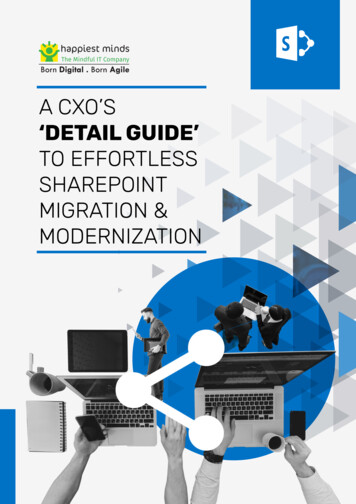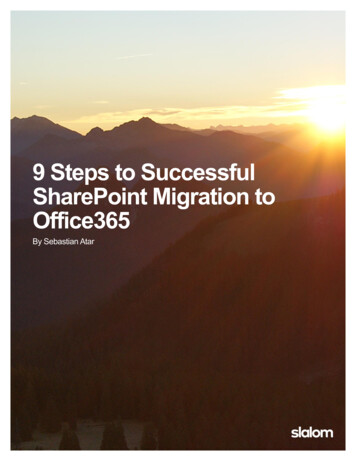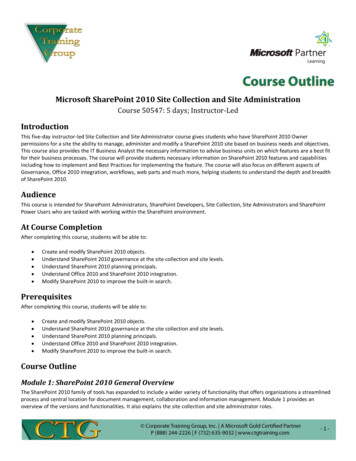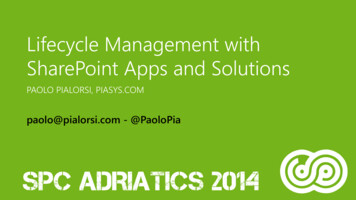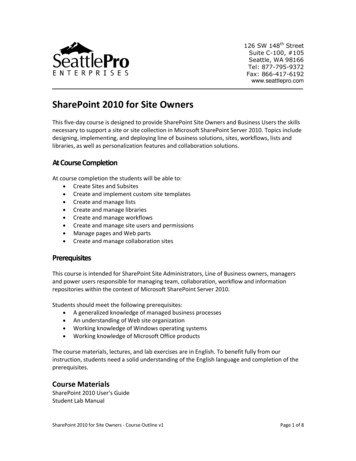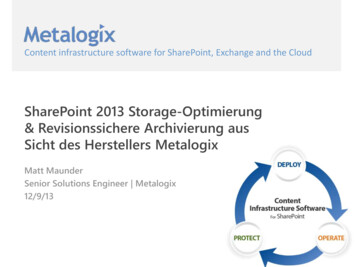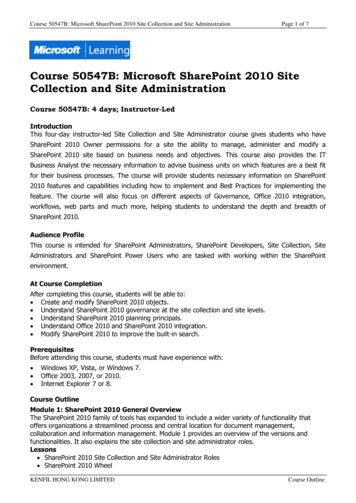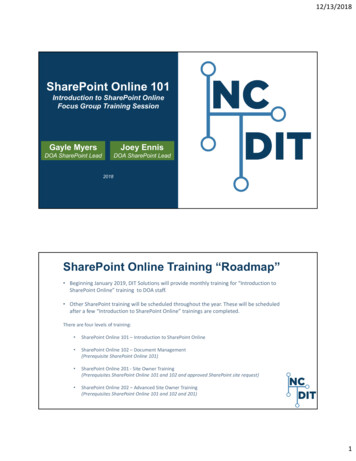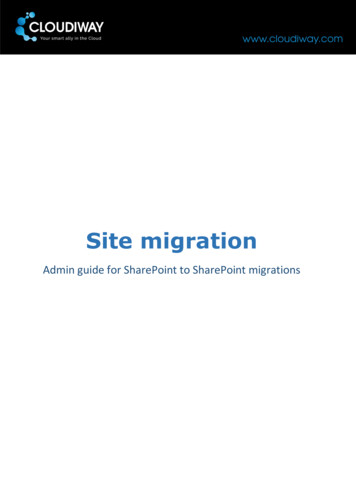
Transcription
Site migrationAdmin guide for SharePoint to SharePoint migrations
Copyright 2017 CLOUDIWAY. All rights reserved.Use of any CLOUDIWAY solution is governed by the license agreement included in your originalcontract.The copyright and all other intellectual property rights in the Software are and remain theproperty of CLOUDIWAY and/or its subsidiaries (“CLOUDIWAY”). The licensee shall not acquireany title, copyright or other proprietary rights in the Software or any copy than specified in.You may not attempt to copy, modify, alter, disassemble, de-compile, translate orconvert in human readable form, or reverse engineer all or any part of theFeatures and/or Data.You acknowledge that the Software and all related products (including but not limited todocumentation) are the subject of copyright. You therefore, shall not during or any time afterthe expiry or termination of this Agreement, permit any act which infringes that copyright and,without limiting the generality of the foregoing, You specifically acknowledge that You may notcopy the Software or Products except as otherwise expressly authorized by this Agreement.CLOUDIWAY provides this publication “as is” without warranty of any either express or implied,including but not limited to the implied warranties of merchantability or fitness for a particularpurpose. CLOUDIWAY may revise this publication from time to time without notice. Somejurisdictions do not allow disclaimer of express or implied warranties in certain transactions;therefore, this statement may not apply to you.Document historyDateEditor28/03/2017 WRChange detailsFirst publicationSite migration: SharePoint to SharePointPage i
Table of Contents11.1Site migration with Cloudiway . 1Supplementary tools . 11.1.1Automatic provisioning . 11.1.2File migration . 12Security during Migration . 23Performance information . 34Site migration scope . 44.1What can be migrated? . 44.2Migration limitations . 44.3Considerations . 54.4Audience . 55Pre-migration configuration . 65.1Before you start. 65.2Pre-migration checklist. 66Use the Cloudiway platform to migrate your sites . 76.1Create your source connector . 76.2Create your target connector .106.3Import sites with the Get Sites command .126.4Add target site collections .146.5Add a SharePoint site manually to Cloudiway .156.6Complete target site details .186.7Import or create a mapping table of user and group details.216.7.1Option 1: CSV import .216.7.2Option 2: Import Users and Import Groups tool .236.7.3Option 3: Create a single user or group .236.8Perform an audit .256.9Activate and monitor your migration .267Troubleshooting . 27Site migration: SharePoint to SharePointPage ii
1Site migration with CloudiwayCloudiway's site migration solution helps businesses perform elaborate technical migrations througha simple SaaS interface. As a result, site migrations require no additional software installation oroverhead, and migrations can be performed securely and quickly.The Cloudiway platform is flexible enough to support all types of migration paths. Your migrationstrategy will depend on your business setup, type and size. Whichever migration path you choose,Cloudiway provides all the essential features such as site content, permissions, site layout and URLs(included rewrites where required). Delta passes are also available, which means you can complete amigration to capture any changes since the initial pass.It's possible to migrate to SharePoint Online from SharePoint On-Premises. Cloudiway site migrationsupports migrations from SharePoint 2010, 2013 and 2016, as well as SharePoint Online.1.1 Supplementary toolsCloudiway has developed a number of tools to enable seamless migration for the most intricatemigrations. Our supplementary tools include: automatic account provisioning (users, distribution lists, shared contacts); and,file migration.1.1.1 Automatic provisioningCloudiway offers an automatic account provisioning tool. It synchronizes your Active Directoryinfrastructure with Office 365 and lets you manage your cloud users from your local Active Directory.It synchronizes users, groups and contacts, and also provides real time password synchronization. Itsupports multi-domain and multi-forest environments and avoids costly directory consolidationprojects. Visit www.cloudiway.com for more information, or contact us.1.1.2 File migrationDuring site migration, files embedded on or attached to web pages are not migrated. To overcomethis, consider using the Cloudiway file migration platform to audit and migrate these files. The filemigration platform is also useful for businesses planning to migrate entirely from one remote systemto another, such as from one Microsoft tenant using Microsoft OneDrive and/or SharePoint toanother. Visit www.cloudiway.com for more information, or contact us.To discuss any of these supplementary tools further, please get in touch with your existing Cloudiwaycontact, or via sales@cloudiway.com.Site migration: SharePoint to SharePointPage 1/27
2Security during MigrationWe take your privacy and security seriously at Cloudiway, and we have invested significant effort intomaking our platform and your data secure. Cloudiway provides a cloud-based application hosted inWindows Azure. It means that the software and data are centrally hosted and accessed by clientsusing a web browser and internet connection. In addition, Cloudiway's SaaS benefits from WindowsAzure's certifications, ensuring security of the infrastructure, network and physical security layers ofthe Cloudiway cloud.For total assurance, Cloudiway provides auditing tools, secure, authenticated data connections and alogging system. More specifically: Cloudiway doesn’t store your mail, files or site data;the migration takes place in memory only: the migration engine connects to the source, pullsdata and pushes it in real time;connections to the source and the target are done using HTTPS so no data is transferredunencrypted over the internet; and,nothing is stored internally: no data persists in the platform.**For the delta pass mechanism, a reference ID of each data migration is stored in internal caches(SQL databases) with the date of modification. This ensures that no data is duplicated, and forefficiency, only the changes are propagated. We automatically delete inactive records after 90 days,or upon request.In addition, because the Cloudiway platform needs credentials to connect to the source and thetarget, you define connectors to connect to them and enter credentials that will be used for theconnection. These credentials are stored encrypted using AES 256.For complete peace of mind, we recommend that you create a temporary migration account duringyour migration which you can delete at the completion of your project.Site migration: SharePoint to SharePointPage 2/27
3Performance informationCloudiway's software platform has been designed and developed to support large migrations.The on-demand migration engine is able to allocate the migration capacity that you need to migratethe volume of data of your choice in the time slot that you have allocated for your migration.Please bear in mind that Office 365 can heavily throttle users. When you perform too many calls,Office 365 begins throttling and decreases the number of calls that can be performed each minute,thus reducing the migration throughput. Cloudiway constantly attempts to work at the maximumcapacity allowed by Office 365 and is able to achieve excellent throughput.Site migration: SharePoint to SharePointPage 3/27
4Site migration scope4.1 What can be migrated?When migrating from SharePoint to SharePoint, the following site items can be migrated: Top Navigation barQuick Launch barPermissionsStructure of siteWelcome pageURLs (rewritten during migration)Document LibrariesLists (Discussion boards, Microfeeds, Announcements, Event Lists, Task Lists, Generic Lists)Web partsComposed Look included in SharePoint FoundationMenuTaxonomyContent TypeWebfieldMetadataSite contentAttachmentsDelta migration on pages and documents only4.2 Migration limitationsSharePoint to SharePoint migrations are relatively straightforward, but some elements cannotcurrently be migrated or are migrated in a specific way, and will need to be identified and addressedas part of any remediation work.Versioning enables you to store, track, and restore items in a list and files in a library as they arechanged. During migration, only the current version is migrated.SharePoint workflows are pre-programmed mini-applications that streamline and automate a widevariety of business processes — from collecting signatures, feedback, or approvals for a plan ordocument, to tracking the current status of a routine procedure. They are not migrated by theSharePoint site migration tool.Typically, a SharePoint solution is deployed to a SharePoint server by using a solution package (.wsp)file. Microsoft SharePoint Foundation has its own system for installing solutions on a SharePointFoundation farm that is different from other Windows applications and platforms. There is no MSIfile or ClickOnce technology involved. The system provides a way to bundle all the components of aSite migration: SharePoint to SharePointPage 4/27
SharePoint Foundation extension into a single new file, which is called a solution package. Solutionpackages are neither migrated nor activated by the SharePoint site migration tool.Alerts are an email and Short Message Service (SMS) notification service in SharePoint Foundation.Users can create rules to receive notifications of changes to list items (item-level alerts), documents,lists (list-level alerts), or document libraries. Alerts are not migrated by the SharePoint site migrationtool yet.Site logos are not currently migrated, but please get in touch for the latest information about this.You can apply composed looks to your SharePoint sites. Composed looks are out-of-the-box themesthat are included in SharePoint 2013 and SharePoint Online. Additional themes are not migrated. TheSharePoint site migration tool only migrates composed looks natively existing in any SharePoint sites.A web part is a modular unit of information that forms the basic building block of a Web Part Page.They enable you to customize a SharePoint page to display content or business data from manysources on the same page. You can also use web parts to display information from external sources,such as RSS feeds or news sites. There are many web parts included with SharePoint Foundation. Youcan also buy web parts from other companies, or, if you want to try your hand at writing code, youcan develop your own. The site migration tool will only migrate web parts included with SharePointFoundation. Custom or third-party web parts are not migrated.SharePoint Add-ins are self-contained extensions of SharePoint websites that you create, and thatrun without custom code on the SharePoint server. (Microsoft) Apps are not transfered duringCloudiway SharePoint migration.4.3 ConsiderationsDelta migration is a Cloudiway functionality that allows you to migrate incrementally. Thisfunctionality is currently used for page and document migrations only. This means that pages anddocuments will never be duplicated at the target.4.4 AudienceThis guide is aimed at experienced system administrators who are capable of connecting to remotesystems and using a variety of administration tools.Although we provide support for our own products, we do not provide support for third partyproducts such as PowerShell or server administration of Google or Microsoft products.If you are concerned you might have any difficulty completing these steps, please consider a solutionwith our consulting team, contactable via presales@cloudiway.com. This will ensure a fast, costeffective and stress-free implementation.Site migration: SharePoint to SharePointPage 5/27
5Pre-migration configuration5.1Before you startBefore you start, you will need to ensure you have the details outlined in the following table.NameDescriptionLocationCloudiway loginStores details and provides communicationbetween the systems you already use.https://apps.cloudiway.comKnowledge baseaccessOur extensive knowledge base is alwaysaccessible, with videos, troubleshootingtools, samples and more.http://kb.cloudiway.comOffice 365account withadmin role formigration atsource andtargetAccount with admin role that bypasses SSOand is able to authenticate usingusername/password credentials,preferably with the format:user@tenant.onmicrosoft.com. Used formigration of permissions only.We recommend you create anaccount with admin accessespecially for migration. After allmigrations are complete, simplydelete this admin account.5.2 Pre-migration checklistYour target sites each have a language setting which can be set if you manually create them. IfCloudiway creates your sites for you, the default language is set to English. If English is not theintended site language, you should create your sites manually first and set the language prior tomigration If you create sites manually before migration, your settings will remain.To ensure successful migration, we also recommend that you follow the checklist Prepare any mapping tables for users and groups in CSV format, ready to upload later on. If migrating from SharePoint On-Premises, provide an admin port to access the SharePoint OnPremises central administration. Create all the target site collections at the SharePoint Online target.By default, the Cloudiway SharePoint site migration tool migrates from a source configuration tothe exact target configuration (although this can be changed too). Check that all target site collections have been created and have the correct time zone setBy default, Cloudiway uses the target site collection time zone for all sites under that collection. Ensure the source and target migration accounts have admin access to all site collections.Site migration: SharePoint to SharePointPage 6/27
6Use the Cloudiway platform to migrate your sites6.1Create your source connectorTo facilitate site migration, the Cloudiway platform needs to be able to communicate with both yoursource and target domains. To do this, Cloudiway uses connectors, which are configured onapps.cloudiway.com. You will need to set up a connector for each source tenant and each targettenant. Follow the steps below to configure a source connector.If you're migrating from SharePoint On-Premises, a small local agent must be run on any on-premisesserver to make the bridge between Cloudiway and the On-Premises server. The agent doesn’trequire any installation —just download and execute from an on-premises server that hasconnectivity with your SharePoint servers. The agent does need network access to the Cloudiwayplatform through port 443, as well as access to the Microsoft Azure Datacenter (find datacenter IPranges at spx?id 41653 ).The agent periodically connects to Cloudiway and listens for new jobs to start. Jobs include: List site;Audit site; and,Migrate site.The agent then runs the job and sends logs and reports to the Cloudiway platform. This means youcan monitor the migration directly from the web interface provided by Cloudiway.1.From your browser, go to https://apps.cloudiway.com and login2.Click on Site Migration on the leftSite migration: SharePoint to SharePointPage 7/27
You can choose to manually set up your connectors, or you can use the simpler process ofthe wizard. The steps below will walk you through the manual process.3.Click on Sources, then on the New option at the bottom of the screen4.Click on SharePoint OnPremise and type a meaningful name in Connector name5.Click on the Create buttonSite migration: SharePoint to SharePointPage 8/27
6.Fill in the remaining details including Server Name (or name of the tenant for SharePointOnline - no www required) and the Administrator fields (your migration admin account)7.For SharePoint Online connectors, click on the Save button and jump to the next section8.For On-Premises connectors, type your five-digit Central Admin Port into the Port field, thendownload the two files to any on-premises server connected to your SharePoint server(s)9.Unzip the downloaded zip file and place the Configuration.json file in the unzipped folder10.Launch cmd.exe and change directories to the unzipped folder location, then typeRun CIW.LocalAgent.exeThe executable will launch and create a connection between the SharePoint on-premisesserver(s) and the Cloudiway migration platform. It will zip up site contents and migrate themto their target destination. The progress of your migration will be displayed in the console, aswell as in the user logs on the Cloudiway platform.11.Click on the Save button at the bottom of the screen to finish the source connector setup.Site migration: SharePoint to SharePointPage 9/27
6.2Create your target connectorWith the source connector now configured on the Cloudiway platform, it's time to create andconfigure the target connector. Follow the steps below to configure a SharePoint Online targetconnector.1.Ensure you're still logged into https://apps.cloudiway.com and click on Site MigrationYou can choose to manually set up your connectors, or you can use the simpler process ofthe wizard. The steps below will walk you through the manual process.2.Click on Targets on the left, then New on the Action bar at the bottom of the screenSite migration: SharePoint to SharePointPage 10/27
3.Click on SharePoint Online and type a meaningful name in Connector name4.Click on the Create button5.Fill in the fields, remembering to use your Office 365 account credentials with administratorrights in the remaining fields6.Click on the Save button at the bottom of the screen.Site migration: SharePoint to SharePointPage 11/27
6.3 Import sites with the Get Sites commandThe Cloudiway platform provides a tool called Get Sites which returns a list of all sites from thedomain you added to the source connector (using the admin credentials you supplied in the sourceconnector). This is a useful tool which provides you with a complete picture of sites to be migrated.You should therefore run this tool prior to site migration to avoid having to manually enter details ofeach site: any syntax errors or spelling mistakes will prevent Cloudiway from finding the intendedsite. This is by far the simplest method of listing the sites to be migrated.1.Ensure you're still in the Site Migration area of apps.cloudiway.com and go to Site List2.Click on the Migration menu at the bottom and select Get Sites to display the followingdialog box:3.Select your source from the dropdown list and click on the Get buttonSite migration: SharePoint to SharePointPage 12/27
The tool will schedule a call to yourdomain to return a list of all visible sitesfor migration.Refreshing the screen will cycle through'Get sites scheduled', 'Get sites working'and eventually, 'Get sites done',presuming your source connector is set upcorrectly.Once the Get Sites tool has completed, it will return a list of all sites discovered via the sourceconnector's credentials. The list will appear in the Site List area of the Cloudiway platform. From thislist, you can check what is due to be migrated prior to migration, edit the target site and collection,assign licenses and delete any sites that don't need to be migrated. These actions are explained inthe following sections.You can also download the results in CSV format for your own records or to make editing changes,and then upload the updated CSV file to the Cloudiway platform as your final list of sites to bemigrated.Note: you cannot add new entries to the CSV file: they must exist on the Cloudiway platform already.If you need to add a new sites, either re-run the Get Sites (which will add newly-available sites to theexisting list) or add a site manually using the steps in section 6.5.Site migration: SharePoint to SharePointPage 13/27
6.4 Add target site collectionsThe Get Sites tool will have captured as many source site details as possible for you, to help avoidspelling mistakes or missed sites. However, it cannot specify target site details. Prior to migration,you will need to create a list of target site collections on the Cloudiway platform and associate themwith each source site (and don't forget to ensure you have created each site collection on yourSharePoint remote system too).1.Ensure you're still in the Site Migration/Site List area of apps.cloudiway.com2.Click on the Collections tab in the top right corner to display the empty list of site collections:3.If you need to add any collections for one or more targets, click on the Create button on theAction bar at the bottom of the pageA pop-up dialog box will appear where you can enter a new collection name:Site migration: SharePoint to SharePointPage 14/27
4.Type the required target collection URL into the field (and make sure it exists in the targetsite collection structure already):5.Click on the Create button, then repeat steps 3 and 4 for any additional site collections6.5 Add a SharePoint site manually to CloudiwayYou can manually add the details of a SharePoint site to your list on the Cloudiway platform. Due tothe possibility of typos, we recommend you only use this option if it's impossible to rerun the GetSites command. You might wish to test migration on a test site you've set up especially for thatpurpose. In this case, adding the site manually might be preferable to using Get Sites. Thestraightforward process is outlined in the following steps.You can manually change each site's name at thetarget, as well as choose whether to migratedirectly to the root site of the collection orsomewhere else (the dropdown for Target sitecollection contains the list of collections youcreated in section 6.4).Toggling the Migrate to the root site of thecollection option will change the relative URL, andyou can use the target fields to create the correctrelative URL to suit your needs.Use the Target site relative URL field to preview thefinal site URL (relative to the target domain) eachtime you make a change to the other target fields.Site migration: SharePoint to SharePointPage 15/27
1.Ensure you're still in the Site Migration area of apps.cloudiway.com and go to Site List2.Click on Manage in the bottom left corner of the action bar and select Create Single todisplay the following screen:Site migration: SharePoint to SharePointPage 16/27
3.Fill in all details for the site, noting how changes to some fields will adjust other fieldsIf you can't find the target site collection in the dropdown list, make sure you created it (seesection 6.4 for steps)4.Adjust the target settings to match your needs, and check the Target site relative URL for thetarget destination, based on your settings: for example, replace spaces with dashes andchoose a target collection, then toggle the switch for migration to the root site of thecollection to see the difference5.Click on the Create buttonThe new site will be added to the Site Migration / Site List screen:Note also that sites with a license assigned appear in green and those without in red6.Repeat steps 1 to 4 for any more sites you'd like to add manually.Site migration: SharePoint to SharePointPage 17/27
6.6 Complete target site detailsWith all sources and target site collections added, you can pinpoint specific target locations withinsite collections to obtain your preferred site structure at the target. You can also delete sites thatdon't need migration, configure individual sites and assign licenses.Before any migration can start, you must assign a license for each source site. You can purchase sitelicenses these within the Cloudiway platform (or contact sales@cloudiway.com for furtherinformation), and these will be displayed on the License dropdown after purchase.Logically, you need to add a target connector from the Target dropdown list before migration canbegin, as well assign any target site collection locations to your source sites prior to migration.Remember, you can manually change each site's name at the target, as well as choose whether tomigrate directly to the root site of the collection. You can use the Target site relative URL field topreview the final site URL (relative to the target domain) each time you make a change to the targetfields.Note: You can assign a target connector and collection to multiple sites from the Action bar at thebottom of the screen. To blanket assign a connector, go to the Manage menu and select AssignTargets (this will apply to all sub-sites). To blanket assign a collection, go to the Set Collection menuand select a collection from the list. In the following steps, individual assignment is explained in moredetail.Site migration: SharePoint to SharePointPage 18/27
1.Ensure you're still in the Site Migration/Site List area of apps.cloudiway.com and click on theSites tab in the top right corner2.Click on a site to be migrated that needs to be assigned to a collection you've just addedBy default, the Statistics tab will be displayed, and these will be empty until migration begins:Site migration: SharePoint to SharePointPage 19/27
3.Click on Edit Site in the top right corner to display the source and target details for a site:4.Click on the License drop-down to assign a license (if you haven't already bought licenses,click on your username in the top right corner and go to the Buy menu option):Site migration: SharePoint to SharePointPage 20/27
5.Adjust the target settings to match your needs, and check the Target site relative URL for thetarget destination, based on your settings: for example, replace spaces with dashes andchoose a target collection, then toggle the switch for migration to the root site of thecollection to see the difference:6.Set up each field according to your needs, and click on the Save Changes button when done7.Repeat the steps above for any other sites listed for migration.6.7 Import or create a mapping table of user and group detailsIn order to migrate access rights for the list of users who have access to each source site, a mappingtable of users must be defined. Office 365 security groups rights can also be migrated using amapping table. A list of mail users is used as mapping tables as it defines who has access to thedifferent sites. It is also used to migrate metadata for files and folders.You can upload a user or group list via CSV, use Cloudiway's automated Import Users tool, ormanually add each user on the Cloudiway platform.6.7.1 Option 1: CSV importIf you have a CSV file of all your site users and another one for groups, you can upload the files toCloudiway. The files must have the following fields in the header row:User CSV: FirstName;LastName;SourceEmail;TargetEmailGroup CSV: Name;SourceEmail;TargetEmailIf you perform more than one upload, any CSV data already uploaded will not be overwritten byfollowing uploads. Therefore, duplicates can occur. Sample CSV files are available to download duringthe steps below.Site migration: SharePoint to SharePointPage 21/27
1.From the Site Migration area of apps.cloudiway.com and go to Mapping Tables2.Click on Manage on the action bar and select Upload CSV3.If required, click on Download sample CSV and add your users to the CSV file using thesample headers (FirstName;LastName;SourceEmail;TargetEmail)4.When you have a complete CSV file with the correct hea
Site migration: SharePoint to SharePoint Page 6/27 5 Pre-migration configuration 5.1 Before you start Before you start, you will need to ensure you have the details outlined in the following table. Name Description Location Cloudiway login Stores details and provides communication between the systems you already use.
